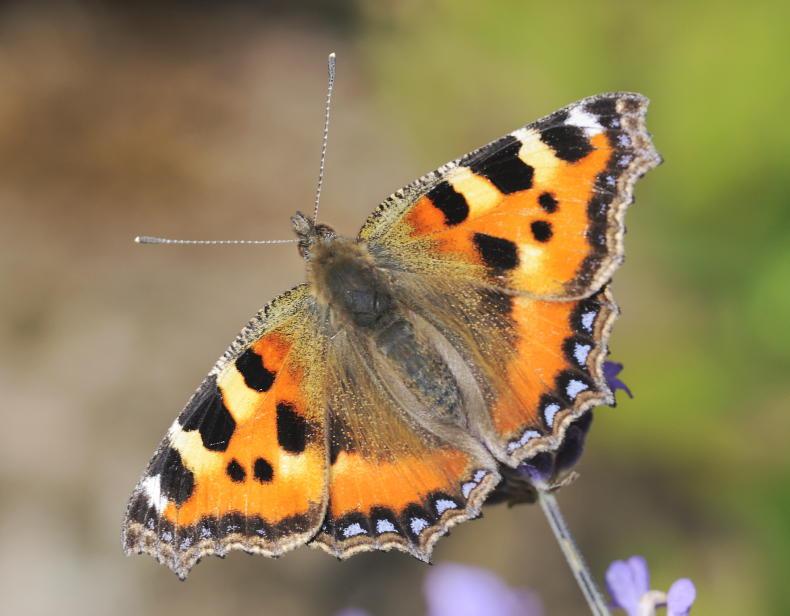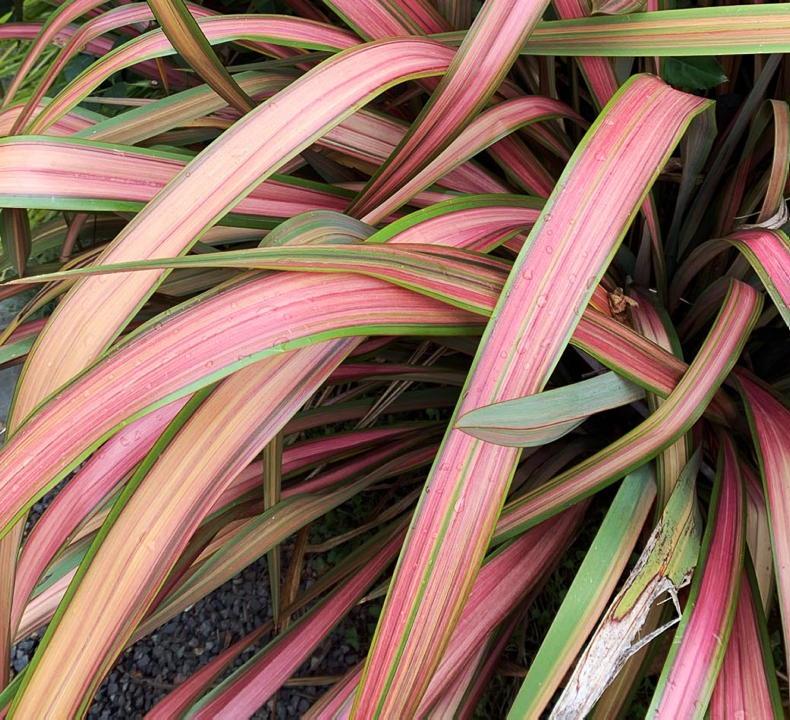Common name: New Zealand flax
Botanical name: The botanical name is Phormium tenax, the second part of the botanical name referring to the New Zealand flax’s truly remarkable ability to withstand severe coastal battery by wind. In fact this and an expectation that strong fibre could be extracted from the leaves were the reasons this plant was brought to these shores in the 19th century. It is a good wind-blocker, though limited in height for shelter purposes, and the fibre-extraction series did not work out at all. The common name New Zealand flax refers to the basic common species and not so much to the more decorative hybrids, but it is these varieties that have been so successful
Botanical family: Phormiacae (the phormium family)
Decorative features
The outstanding feature of the New Zealand flax is its remarkable foliage. Recognised to be very wind resistant, it also has the quality of lasting year-round, indeed, some leaves last for years, creating a dense clump capable of suppressing weeds in the vicinity. Not only is it wind resistant and evergreen, but the upright manner of growth – or an arching habit that some kinds adopt – looks very well when planted with trees and shrubs. Although the original plants were plain green, a remarkable range of leaf colours have been bred in recent decades, ranging from green, yellow, red, pink, purple and almost black.
Garden use
This range of colour is particularly attractive in winter and early spring, when there is little colour in the garden, especially the red and pink tones, and purples, to offer contrast with the general green or grey or brown of the bark of many trees. The range of size is from 1m to 3-4m in ideal conditions.The flower spikes can be even taller. But these are not particularly decorative, and are often removed once they have started to flop around. The big ones are still used in parts of the West of Ireland as shelter plants, even in places where the salt surf would fall on them.
Site requirements
Phormiums are not fully hardy, and were killed in large numbers across the country in the severe frost of 2010. So much so, that many people doubted whether they would ever plant them again. But the 2010 frost and snow have been forgotten and people are planting them again.
Soil requirements
Phormium grows well in any ordinary garden soil, either limy or acidic. The ground should drain reasonably well after rain. It can be propagated to give new plants by simply splitting the existing plant. The decorative kinds were originally selections and sometimes they revert to the original green and these should be taken out as they will take over, being more vigorous. CL
Outwintering butterflies

It is quite a common experience to find unattached wings on the floor of a garage or garden shed, pretty much any kind of building that is exposed and easily accessed. Although it can be a bit of a mystery when first encountered, there is no confusion about what is happening. Overwintering butterflies are the regular prey of some small bird species.
The main culprit is the much-admired, tiny but indomitable wren. The common wren’s scientific name is Troglodytes troglodytes, which is Latin for a cave dweller and is applied to many species of different kinds of animal that live in, or use caves in the wild. It has been long observed leaving caves and cave-like structures and it was easy to assume they were living there but, in reality, the little wren visits caves to feed on spiders, butterflies and other insects, eating the nutritious insect body, leaving aside the wings.
It is somewhat ironic that the food of the most common garden bird is the most common garden butterfly, namely, the small tortoiseshell noted for its patches of red, yellow and spots of bright blue on the wings. These birds also attack butterflies and other insects outdoors during the summer when they are flying. Although far less common, the larger peacock butterfly is also hunted down in dark places.
The small tortoiseshell butterfly has dark colouring and irregular patterns on the underside of the wings that help to disguise it while they are feeding on the flowers of leafy plants, and also when the butterfly is hibernating in winter in caves and similar structures. The species is commonly found indoors tucked away in dark corners with its wings folded.
Fruit, vegetables and herbs
Prune apple and pear trees. Check on young fruit trees. Lift rhubarb stools for forcing in a dark, warm place. Seed potatoes of early varieties can be put in to sprout now. For early crops, sow the seeds of early varieties of cabbage, cauliflower, carrots, lettuce and onions now.
Trees, shrubs and roses
Check trees and shrubs planted last year for signs of wind-rocking. Young trees that have been wind-rocked may need to have more soil placed around them and re-firmed, or even staked if necessary. The ground has been too wet for planting on and off in recent times.
Flowers
Bedding flowers, such as geraniums, impatiens and lobelia, can be started off in a heated propagator now, but it is still too early for most of the easy kinds, such as cosmos. If the ground is not too wet, border flowers can be lifted and divided, if necessary, due to their spreading.
Lawns
In a good spell of weather, if the soil is firm enough, a first mowing can be carried out as soon as possible. If the lawn area has drainage, make sure that the drainage outlets are clear to allow surplus water to escape. The lawnmower should be serviced and the blades sharpened.
Greenhouse and house plants
Begin watering a little. Check also for signs of greenflies and other pests as these can cause severe damage to greenhouse plants. House plants should be kept just barely moist and moved to a bright position, or at least rotated with other plants to give them some good light.






 This is a subscriber-only article
This is a subscriber-only article










SHARING OPTIONS: